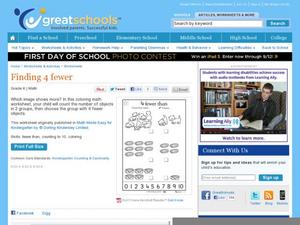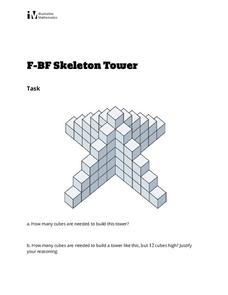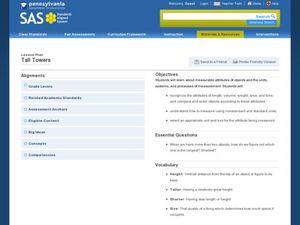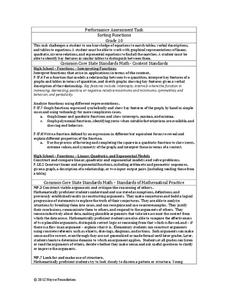Curated OER
Number Search in Monterey Bay Aquarium
Youngsters search for an animal with body parts for each number from one to ten during a field trip to an aquarium. They count rays, fins, feet, gills, eyes, spots or anything. When they get back to the classroom, they compile their...
Curated OER
Conventions: Adjectives
Investigate adjectives with writers. They define adjectives and create their own sentences describing objects found at home using adjectives correctly. Focus on the five senses and sensory details.
DK Publishing
2 More Than
Which one has two more? Each row of objects has a corresponding row, and mathematicians determine which one has two more than the other, checking it off. They work with single-digit values here and should be encouraged to write the...
DK Publishing
4 Fewer Than
Which image has four fewer? There are three sets of objects here which introduce subtraction concepts to beginning mathematicians (although the word subtraction and its symbol do not show up here). They count the number of...
Houghton Mifflin Harcourt
Sums to 100
Whether it's counting marbles, flowers, or playing cards, small objects can add up to great sums. Learners work six story problems to practice addition to 100. Some regrouping is required, along with distinguishing useful from irrelevant...
Illustrative Mathematics
Seeing is Believing
How many visual models can be used to show multiplication? Three basic kinds of models can be used to represent and explain the equation 4 x (9 + 2). The commentary section provides description and graphics to explain the set...
Illustrative Mathematics
Measure Me!
How many unifix cubes tall are you? If you're not sure, then perform this math activity with your class and find out. Working in pairs, young mathematicians make measuring sticks out of unifix cubes in order to determine the length of...
Illustrative Mathematics
Christina's Candies
Help Christina figure out how many chocolate and lemon candies she has with a lesson on decomposing numbers. When presenting this context to the class, the teacher chooses the total number of candies and the number that are chocolate,...
Curated OER
Ordinal Numbers
Introduce ordinal numbers with this simple teaching tool. Young mathematicians trace numbers from 1 to 5. Then they circle the object in a row of 5 that represents the numerical place of the number they just traced. Example: Students...
Curated OER
M & M Madness
M&M's are always a great manipulative to use when teaching math. In this graphing lesson plan, learners predict how many of each color of M & M's there are. They count up each color and plug the data into a graph using the...
Curated OER
Skeleton Tower
Your algebra learners build a quadratic function in this task of counting the blocks used to build objects. The arithmetic sequence that shows up brings up a shortcut to the long addition using the Gauss Method. Eventually, learners...
Curated OER
Using Arrays to Show Multiplication Concepts
Learners practice multiplication concepts. In this multiplication activity, pupils make arrays by using counters and solve various multiplication questions. They model arrays with counters for reinforcement.
Curated OER
A Weigh we Go!
Here are some cross-curricular activities whil should help your kids understnad weight measurements and grammar. In this grammar and math lesson, students read the book Skittles Riddles and practice counting and balancing skittles. They...
Virginia Department of Education
Weather Patterns and Seasonal Changes
Get your class outside to observe their surroundings with a lesson highlighting weather patterns and seasonal changes. First, learners take a weather walk to survey how the weather affects animals, people, plants, and trees during...
Curated OER
Tall Towers
Linear measurement is the focus of this math lesson. Youngsters work in groups to build towers with blocks. They build towers represented on index cards and determine how many blocks taller one tower is.
Curated OER
Nonstandard Units
Here is a very good measurement activity. Four problems are solved in which objects at home are measured using the specified nonstandard measurement units such as toothpicks, footsteps and teaspoons.
Curated OER
Tomato Exploration
Create tomatoes in 15-20 minutes using this fun and interactive lesson plan! Learners listen to a book about tomatoes (recommendations listed), and focus on the vocabulary word tomato. They count the syllables...
Curated OER
Jack and The Beanstalk Estimation
Introduce the day's lesson by reading Jack and The Beanstalk by Richard Walker, and then review the concept of area with your class. We don't always need rulers to measure, though! Teach learners how to use their hands to help us measure...
Curated OER
Patterns, Relations, and Functions: Geometric Shapes
Young scholars explore patterns involving objects or figures and geometric shapes. They identify the missing shapes in patterns and discuss what would come next in the pattern, analyze patterns using different objects, and complete a...
Charleston School District
Volume of Composite Shapes
It's the parts that make the whole. Learners apply volume formulas to composite figures to find the total volume of the figure. Previous lessons in this series taught the methods for finding the volume and/or dimensions of...
Curated OER
"Ing" Words as Descriptors
This clever lesson has your students listen to story about bugs, work together to brainstorm list of "ing" words that describe bugs, create t-chart of words, choose words to place in poem template to create class poem about bugs, and use...
It's About Time
Sounds in Strings
How many of your pupils play an instrument? A musical science lesson will help all of them understand how string instruments work. Young scientists construct a string-and-pulley system to test frequency and pitch. The lesson...
Inside Mathematics
Sorting Functions
Graph A goes with equation C, but table B. The short assessment task requires class members to match graphs with their corresponding tables, equations, and verbalized rules. Pupils then provide explanations on the process they used to...
American Museum of Natural History
If Trash Could Talk
Trash can talk! Young archaeologists dig through their trash to see what it reveals about their lives. After they examine their midden, links permit users to test their knowledge of archaeology with a 10-questions quiz, learn how...























